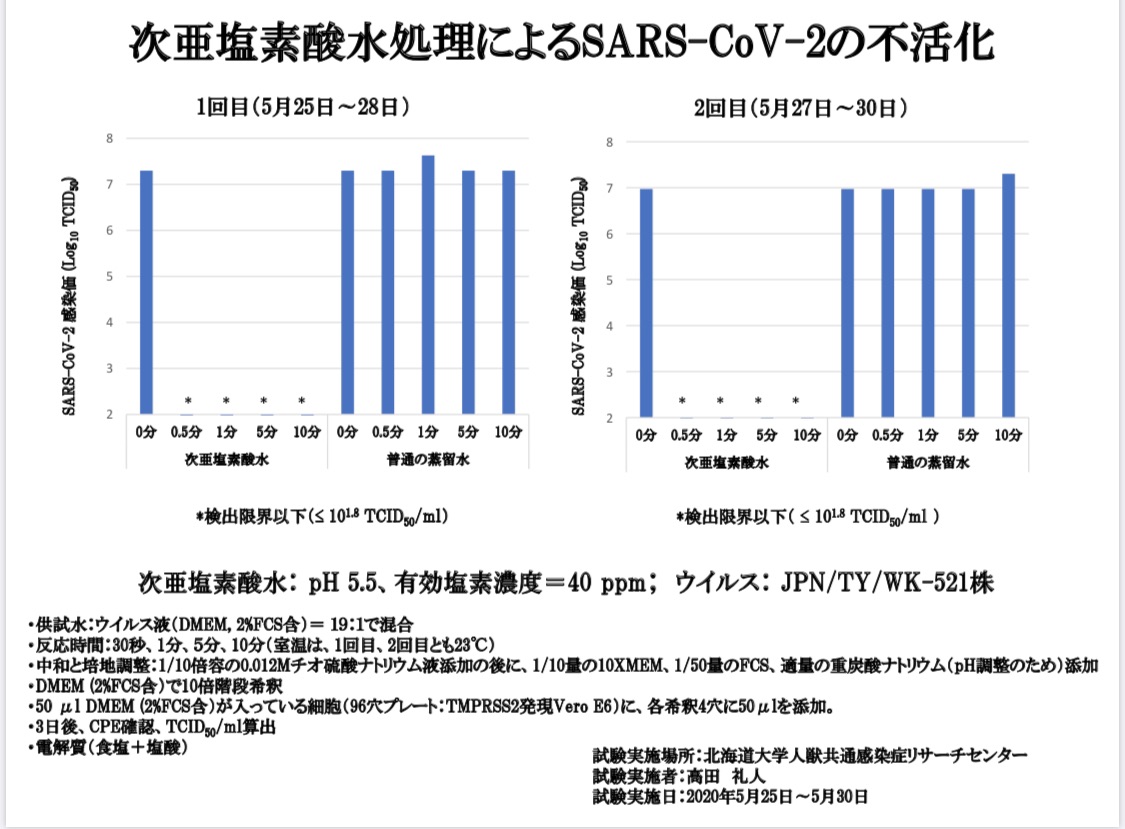【2020年6月2日公表】最新情報‼NITEの中間報告と同条件で「次亜塩素酸水で新型コロナウイスが瞬時に不活化することを実証」した報道内容を解説。
We will explain the contents of the press release issued by PR Times on June 2nd regarding "inactivation of the new coronavirus with hypochlorous acid water"! (Source information: https://prtimes.jp/main/html/rd/p/000000003.000056737.html)

1. What is written in it? Summary
1) On May 29th, the National Institute of Technology and Evaluation (NITE), which was commissioned by the Ministry of Economy, Trade and Industry to carry out verification work, announced that in a verification test of hypochlorous acid water (produced by electrolysis), "the effectiveness of the product cannot be determined from the results of this test, so evaluation will continue." (Source: https://www.nite.go.jp/data/000109489.pdf)
2) The National Institute of Infectious Diseases and Kitasato University, which conducted the verification in this announcement, have announced that they will continue to conduct verification tests on hypochlorous acid water (produced by methods other than electrolysis).
3) The National Institute of Infectious Diseases and Kitasato University each conducted tests under different conditions to verify whether hypochlorous acid water produced by electrolysis would inactivate the new coronavirus. However, following the results that showed that the effectiveness of the test could not be proven at this time, the Hokkaido University Research Center for Zoonosis Control also conducted tests to verify whether hypochlorous acid water (produced by electrolysis) would inactivate the new coronavirus under the conditions used by the National Institute of Infectious Diseases.
2. What kind of verification tests did the Hokkaido University Research Center for Zoonosis Control conduct?
The test was conducted under the same conditions as NITE, but I'm sure many people are curious about what kind of verification tests NITE conducted in the first place. So, I'll share the verification content information as a reference source.
* Reference: "Interim results of verification tests for evaluating the effectiveness of alternative disinfection candidates using the new coronavirus (May 28, 2020, National Institute of Technology and Evaluation)" https://www.nite.go.jp/data/000109487.pdf)
Specifically, in an environment at room temperature of 23°C, hypochlorous acid water (produced by electrolysis) with a pH of 5.5 (slightly acidic hypochlorous acid water) and an effective chlorine concentration of 40 ppm was mixed with a novel coronavirus liquid in a ratio of 19:1, and the extent to which the novel coronavirus was inactivated was examined every 1 minute, 5 minutes, and 10 minutes.
3. Explanation of the presentation contents
The Hokkaido University Research Center for Zoonosis Control announced that after conducting the above two verification tests twice, the new coronavirus was inactivated by 99.9%.
<Explanation and hypothesis>
A verification experiment was conducted to see whether the new coronavirus would be inactivated by mixing slightly acidic hypochlorous acid water (pH 5.5) with an effective chlorine concentration of 40 ppm, which is within the range of food additives specified by the Ministry of Health, Labor and Welfare, at room temperature of 23°C in a ratio of 19:1 (hypochlorous acid water: new coronavirus). It was announced that the virus was inactivated 99.9% within one minute, but not when the effective chlorine concentration was lower. In addition, a verification test at Kitasato University showed that the new coronavirus liquid could not be inactivated when it was mixed with slightly acidic hypochlorous acid water (pH 5.0-6.0, effective chlorine concentration 50 ppm) in a ratio of 1:9. This means that the effectiveness of the new coronavirus may be affected by the effective chlorine concentration and spray ratio (amount) of the hypochlorous acid water. Since hypochlorous acid water may inactivate the new coronavirus, verification tests will continue.
* Reference: "Interim results of verification tests for evaluating the effectiveness of alternative disinfection candidates using the new coronavirus (May 28, 2020, National Institute of Technology and Evaluation)" https://www.nite.go.jp/data/000109487.pdf)
4. It is expected that spraying large amounts of hypochlorous acid water with a stable concentration will increase the possibility of inactivating the new coronavirus.
As can be seen from the above content of 3, the conditions for inactivating the new coronavirus with hypochlorous acid water are assumed to be that the available chlorine concentration of the hypochlorous acid water remains stable for a long period of time and that it is sprayed in large quantities.
However, the hypochlorous acid water (produced by electrolysis) announced by the Ministry of Health, Labor and Welfare and the Ministry of Economy, Trade and Industry was announced primarily for its widespread distribution in local areas to alleviate the shortage of alcohol-based disinfectants, and many people have questioned its effectiveness.
5. About Perfect Clear (electrostatically filtered hypochlorous acid water)
Perfect Clear (electrostatically filtered hypochlorous acid water) is a miscellaneous item whose only ingredients are "hypochlorous acid water and purified water" produced using a patented manufacturing process (JP6230079B1).
It also falls under the category of hypochlorous acid water produced by methods other than electrolysis, for which NITE will be conducting future verification experiments.
Although this is still tentative, based on the results of testing by NITE and Hokkaido University, hypochlorous acid water produced using the patented method (electrostatic filtration) is able to stabilize the "available chlorine concentration," a concern with hypochlorous acid water produced using electrolysis, and so there are high hopes that it will be able to inactivate the new coronavirus.

